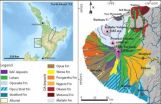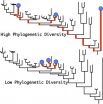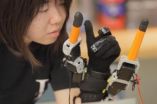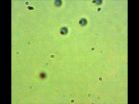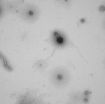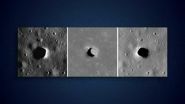In alcohol abusers, fish oil may reduce risk of neurodegeneration and ensuing dementia
2014-07-18
(Press-News.org) MAYWOOD, Ill-- Omega-3 fish oil might help protect against alcohol-related neurodamage and the risk of eventual dementia, according to a study published in the journal PLOS ONE.
Many human studies have shown that long-term alcohol abuse causes brain damage and increases the risk of dementia. The new study found that in brain cells exposed to high levels of alcohol, a fish oil compound protected against inflammation and neuronal cell death.
The study was conducted by Michael A. Collins, PhD, Edward J. Neafsey, PhD, and colleagues at Loyola University Chicago Stritch School of Medicine, and collaborators at the University of Kentucky and the National Institute of Alcohol Abuse and Alcoholism (NIAAA).
Collins and colleagues exposed cultures of adult rat brain cells over several days to concentrations of alcohol equivalent to about four times the legal limit for driving – a concentration seen in chronic alcoholics. These brain cultures were compared with cultures exposed to the same high levels of alcohol, plus a compound found in fish oil called omega-3 docosahexaenoic acid (DHA).
Researchers found there was up to 90 percent less neuroinflammation and neuronal death in the brain cells exposed to alcohol plus DHA than in the cells exposed to alcohol alone.
An earlier meta-analysis by Collins and Neafsey, which pooled the results of about 75 studies, found that moderate social drinking may have the opposite effect of reducing the risk of dementia and/or cognitive impairment during aging. (Moderate drinking is defined as a maximum of two drinks per day for men and 1 drink per day for women.)
It appears that limited amounts of alcohol might, in effect, tend to make brain cells more fit. Alcohol in moderate amounts stresses cells and thus toughens them up to cope with major stresses and insults down the road that could cause dementia. But too much alcohol overwhelms the cells, leading to neuroinflammation and cell death.
Further studies are needed to confirm whether fish oil protects against alcohol-related cognitive injury and dementia in adult rodent models. "Fish oil has the potential of helping preserve brain integrity in chronic alcohol abusers," Collins said. "At the very least, it is unlikely that it would hurt them."
But Collins added that the best way for an alcohol abuser to protect the brain is to cut back to low or moderate amounts or quit entirely. "We don't want people to think it is okay to take a few fish oil capsules and then continue to go on abusing alcohol," he said.
INFORMATION:
PLOS ONE is an international, peer-reviewed, open-access online journal. Collins earlier reported findings at the 14th Congress of the European Society for Biomedical Research on Alcoholism in Warsaw.
Collins, principal investigator of the study, is a professor in the Department of Molecular Pharmacology and Therapeutics at Loyola University Chicago Stritch School of Medicine. Co-authors are Neafsey, Nuzhath Tajuddin, MS, and Kwan-Hoon Moon, PhD, of the Stritch School of Medicine; Kimberly Nixon, PhD, of the University of Kentucky; and Hee-Yong Kim, PhD, of the NIAAA. The research was funded by grants from the NIAAA at the National Institutes of Health.
ELSE PRESS RELEASES FROM THIS DATE:
Weight management program also reduces depression among black women
2014-07-18
DURHAM, N.C. -- An intervention program aimed at helping obese women maintain their weight without adding pounds also significantly reduced depression in nearly half the participants, according to a new study from Duke University.
The study was conducted with 185 low-income black women ages 25-44, each with a body mass index (BMI) of 25 to 35, who were receiving primary care at five community health centers in central North Carolina.
The program used software built by Duke researchers that personalized a weight-gain prevention intervention called the Shape Program for ...
Catastrophic debris avalanches -- a second volcanic hazard
2014-07-18
Boulder, Colo., USA – Volcanic hazards aren't limited to eruptions. Debris avalanche landslides can also cause a great deal of damage and loss of life. Stratovolcanoes, with their steep, conical shapes made up of lava and unconsolidated mixed materials, can reach a critical point of instability when they overgrow their flanks. This leads to partial collapse, and the product of this slope failure is a large-scale, rapid mass movement known as a catastrophic landslide or debris avalanche.
In a matter of minutes, a debris avalanche can drastically modify the shape and nature ...
Bowel cancer breakthrough may benefit thousands of patients
2014-07-18
Researchers at Queen's University have made a significant breakthrough that may benefit patients with bowel cancer.
Dr Sandra van Schaeybroeck and her team have discovered how two genes cause bowel cancer cells to become resistant to treatments used against the disease. The research, which was funded by Cancer Research UK, was published this month in the prestigious international journal Cell Reports.
The activity of the two genes, called MEK and MET, was uncovered when the researchers looked at all the different pathways and interactions taking place in bowel cancer ...
Scientists enlist big data to guide conservation efforts
2014-07-18
Despite a deluge of new information about the diversity and distribution of plants and animals around the globe, "big data" has yet to make a mark on conservation efforts to preserve the planet's biodiversity. But that may soon change.
A new model developed by University of California, Berkeley, biologist Brent Mishler and his colleagues in Australia leverages this growing mass of data – much of it from newly digitized museum collections – to help pinpoint the best areas to set aside as preserves and to help biologists understand the evolutionary history of life on Earth. ...
A new measure of biodiversity
2014-07-18
A new approach to measuring biodiversity has uncovered some biologically important but currently unprotected areas in Western Australia, while confirming the significance of the world heritage listed Wet Tropics rainforests in the country's north-east.
In a paper published yesterday (Friday 18 July) in Nature Communications, scientists from CSIRO, University of California, University of Canberra, the Australian Tropical Herbarium at James Cook University and University of New South Wales applied the new method to Australia's iconic Acacia.
The genus Acacia includes ...
Getting a grip on robotic grasp
2014-07-18
CAMBRIDGE, MA -- Twisting a screwdriver, removing a bottle cap, and peeling a banana are just a few simple tasks that are tricky to pull off single-handedly. Now a new wrist-mounted robot can provide a helping hand — or rather, fingers.
Researchers at MIT have developed a robot that enhances the grasping motion of the human hand. The device, worn around one's wrist, works essentially like two extra fingers adjacent to the pinky and thumb. A novel control algorithm enables it to move in sync with the wearer's fingers to grasp objects of various shapes and sizes. Wearing ...
Biomarker discovery may lead to new HIV treatment
2014-07-18
Further analysis of a Phase II study of therapeutic HIV vaccine candidate Vacc-4x revealed a potential biomarker associated with participants who experienced a more profound viral load reduction after receiving the vaccine. The results of this exploratory, ad hoc, subset analysis by St George's, University of London and Bionor Pharma were announced today at the AIDS 2014 Conference in Melbourne, Australia.
If confirmed, the biomarker may be able to predict which patients will benefit most from the therapeutic HIV vaccine candidate Vacc-4x, which is being developed by ...
'Nanocamera' takes pictures at distances smaller than light's own wavelength
2014-07-17
VIDEO:
This is a video demonstrating scanning-stage-based exposure, whereby programmed
motion of a microscope stage is used to write the University's "Block I " logo into the plasmonic film. Each bar in the...
Click here for more information.
Researchers at the University of Illinois at Urbana-Champaign have demonstrated that an array of novel gold, pillar-bowtie nanoantennas (pBNAs) can be used like traditional photographic film to record light for distances that ...
Tiniest catch: University of Arizona scientists' fishing expedition reveals viral diversity in the sea
2014-07-17
A fishing expedition of microscopic proportions led by University of Arizona ecologists revealed that the lines between virus types in nature are less blurred than previously thought.
Using lab-cultured bacteria as "bait," a team of scientists led by Matthew Sullivan has sequenced complete and partial genomes of about 10 million viruses from an ocean water sample in a single experiment.
The study, published online on July 14 by the journal Nature, revealed that the genomes of viruses in natural ecosystems fall into more distinct categories than previously thought. This ...
Lunar pits could shelter astronauts, reveal details of how 'man in the moon' formed
2014-07-17
VIDEO:
This video shows images from NASA's LRO spacecraft of various lunar pits.
Click here for more information.
While the moon's surface is battered by millions of craters, it also has over 200 holes – steep-walled pits that in some cases might lead to caves that future astronauts could explore and use for shelter, according to new observations from NASA's Lunar Reconnaissance Orbiter (LRO) spacecraft.
The pits range in size from about 5 meters (~5 yards) across to more than ...
